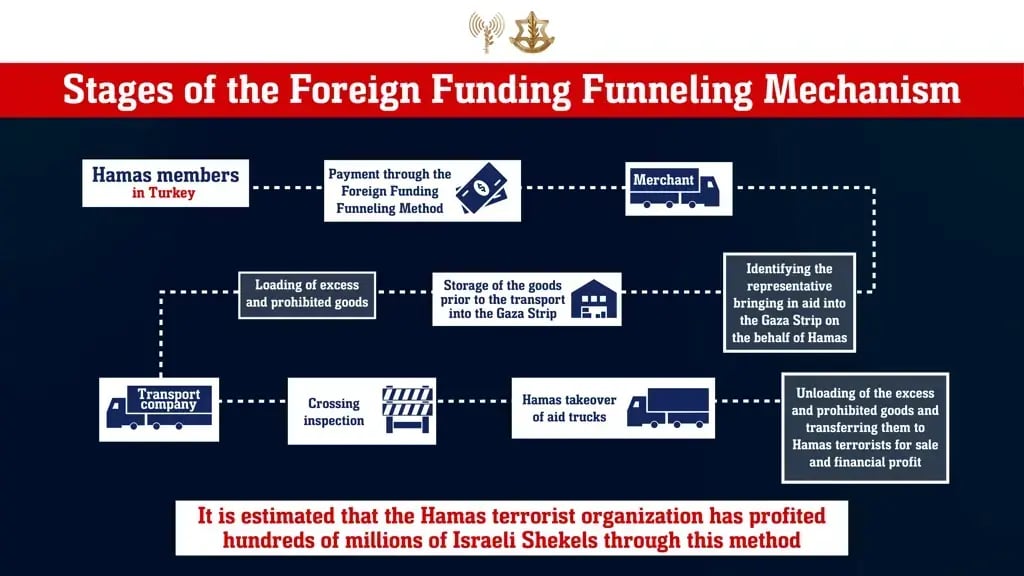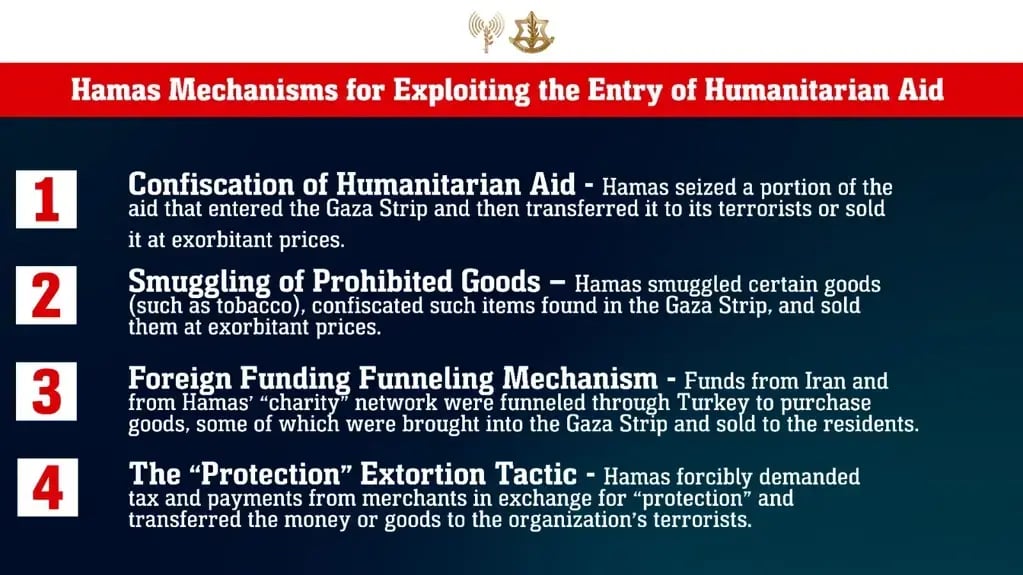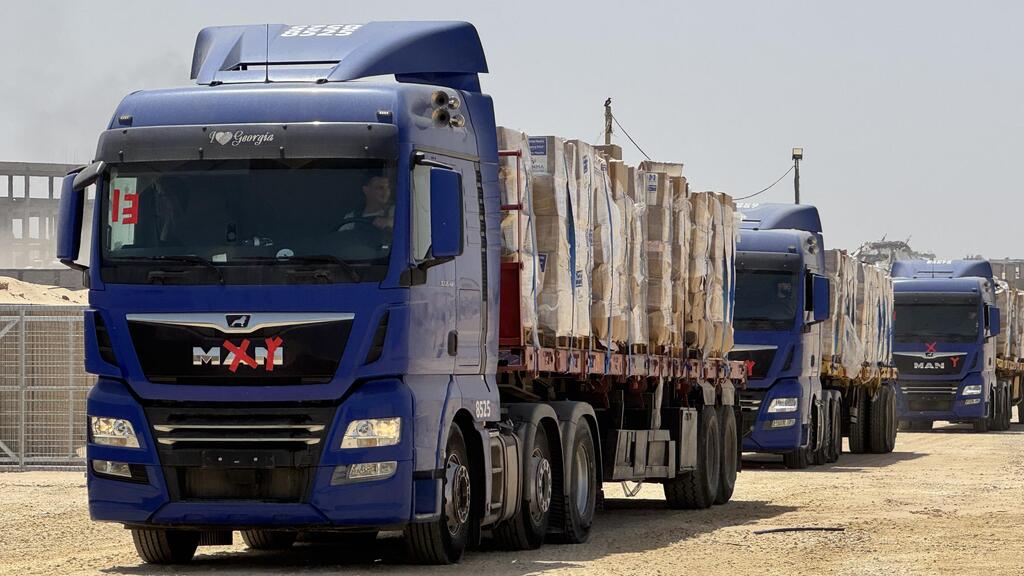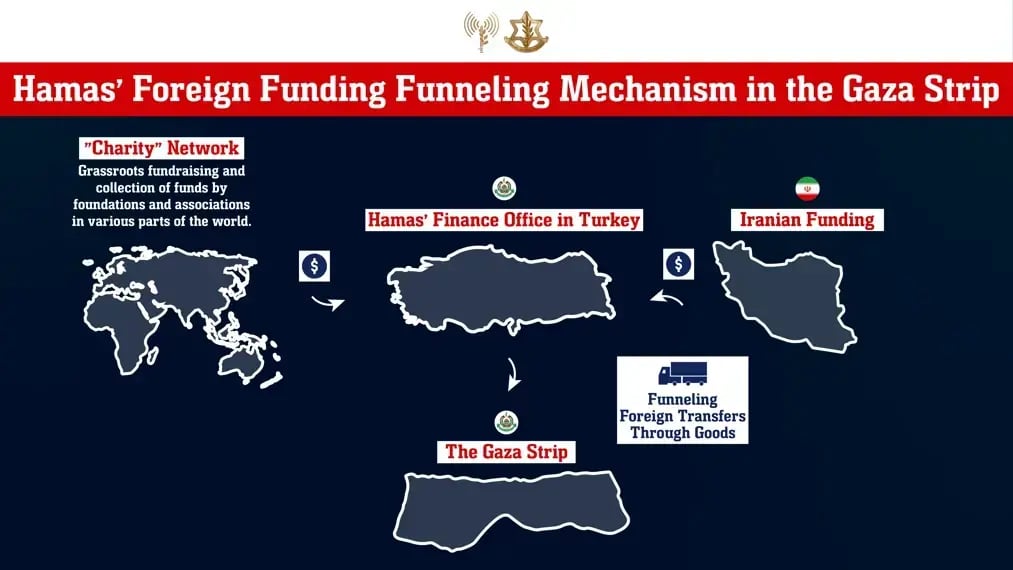As the U.S.-based GHF aid foundation issued a sharp condemnation of Hamas for a deadly attack on an aid workers' bus in Gaza, the IDF revealed evidence of Hamas’ economic exploitation of humanitarian assistance meant for civilians in the Strip.
During the war, according to an IDF spokesperson, Hamas operatives joined aid convoys—sometimes openly, sometimes under disguise—to seize and take control of goods meant for civilians. Based on intercepted conversations and authentic documents, Israeli intelligence found that Hamas declared itself the authority over humanitarian aid distribution in Gaza, and in practice commandeered large portions of it. Documents revealed that Hamas established fixed quotas—between 15% and over 25%—of all aid to be diverted systematically for its own use.
A document discovered in the Gaza Strip and published Thursday shows an official Hamas decision to set the percentage of aid confiscation and adjust it periodically based on internal assessments. The diverted aid was reportedly either sold for profit in local markets or distributed to Hamas fighters and officials. Additional information points to the smuggling of cigarettes into Gaza, sold at inflated prices by Hamas members, who also threatened independent vendors.
The IDF believes Hamas exploited the logistics of aid organizations, whether through direct cooperation or deception, and profited hundreds of millions of shekels from the scheme.
As part of the disclosure, the IDF presented a graphic outlining the four mechanisms Hamas used to exploit aid: confiscation, smuggling, skimming (deductions) and protection rackets, along with flow charts of external money transfers, intercepted calls between Gaza residents describing the system, and official Hamas documents—some with translated versions—detailing internal directives for allocating aid quotas.
In one intercepted call, presented by the IDF, two Gaza residents describe how Hamas looted UNRWA flour warehouses and then sold the flour to civilians at steep prices. “They got the flour for free; they are selling it for 120 shekels, while I sell it for 60,” says one. He adds that Hamas operatives broke into UNRWA mills and stole their contents. The call is filled with anger, frustration and bitter irony: “To hell with them… Whatever happens to them—it’s not enough. They all are thieves. They all are dogs.”
The investigation also uncovered significant financial ties between Hamas and actors in Turkey and Iran, with funds transferred to Gaza through the hawala system—unofficial remittance channels involving middlemen. These funds were used to purchase “excess aid” smuggled into Gaza under humanitarian cover and later sold to residents at high prices.
Moreover, Hamas engaged in extensive collection of “security fees”—in practice, protection money—from aid distributors, merchants and small businesses. According to intelligence sources, Hamas leveraged its de facto control over the territory to take over entire industries, impose coercive taxes, and ensure that no cash flow bypassed the group.
Meanwhile, GHF, a humanitarian aid initiative operating in Gaza independently of Hamas, issued a strongly worded statement after a bus carrying Palestinian workers to a distribution center was attacked. The statement said five were killed, others were wounded, and some may have been kidnapped. GHF placed full responsibility on Hamas, saying: "The attack did not happen in a vacuum. For days, Hamas has openly threatened our team, our aid workers and the civilians who receive aid from us. Their threats have been met with silence."
Hamas operatives claimed the victims belonged to the Abu Shabab militia allegedly armed by Israel. However, sources within that militia vehemently denied the claim and issued a statement naming Hamas members allegedly responsible for the attack. “The blood of your workers has been spilled—and we will reveal all the evidence,” the statement warned, addressing Gaza residents.
Get the Ynetnews app on your smartphone: Google Play: https://bit.ly/4eJ37pE | Apple App Store: https://bit.ly/3ZL7iNv
According to the IDF, since March—when the Israeli government temporarily halted aid deliveries—Hamas has seen a sharp decline in revenue, causing liquidity problems and even suspensions in fighter salaries. In response, Israel developed a strict oversight mechanism involving organizational registration, customs procedures, security screening, and limitations on goods—with a sanction system for violators.
Currently, aid is distributed primarily through centers run by international organizations under the security oversight of GHF, in a structure that removes Hamas from the logistics chain.
“This is clear evidence for the world,” said the IDF spokesperson. “Hamas does not protect Gaza’s civilians—it cynically exploits them for military and financial gain. The IDF will continue to ensure that aid reaches civilians, not the terror group.”






